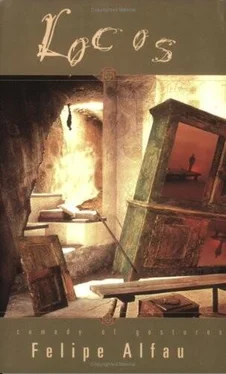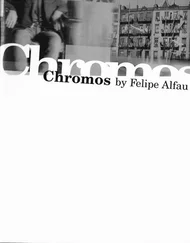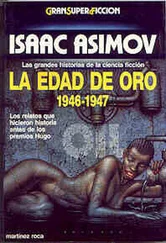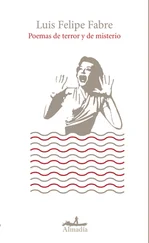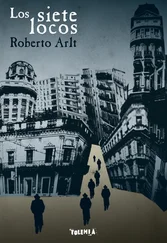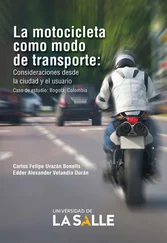My sentence seemed to last very long. Everything in that room appeared to be in a state of suspended animation. We were standing at opposite sides of the bed; Dr. de los Rios had his back to the window and I could only see his outline against the dim light. Evening was coming on fast and the last light was concentrated upon the ivory crucifix and the dead body that lay between us. My sentence was still hanging in the air as if unable to penetrate the death wall that separated us. Dr. de los Rios rose slowly, his outline growing into immense proportions that frightened me. The bistoury glittered in his hand among the gathering shadows like the last light of wisdom trying to pierce the darkness of mystery, endeavoring to reach and dissect the beyond. And then he answered:
“Because putrefaction is the return to life. It is then that life snatches a body from death and claims it as its own. This woman loves death too much. She loves death for itself and has detached it from all the intimate links that bind it to life. Through decomposition a body returns to life, having lost its identity and personality. She wants to remain herself so that when she revives she will know that she has been dead. She only wants the decorative and ephemeral part of death. She regards death only in its purest sense, separated from all its usual and necessary developments within nature. That is why putrefaction does not begin in her. It is too obvious a sign of life and she hates life. But how she can arrest death, how her will can hold good past the boundaries of her life is beyond me.”
And Dr. José de los Rios seemed to rise farther, his arm reaching for an invisible fleeting truth. And then the light went out in his bistoury and we were submerged in thick shadows. All I remember then is that Dr. de los Rios took me by the arm and we rushed through the darkness and out of that house of death into the street.
I never knew whether my experiences of that day were a dream or reality. I was busy all that summer and did not see Dr. de los Rios again until the fall. When I saw him I referred to the subject.
“I was finally able to diagnose her case more clearly,” he said. “You know? Doña Micaela Valverde was in love with death as I often said. Of course, almost everybody has an interest in death, just as they have an interest in sex. It is the natural curiosity for the beginning and end of existence which affects them very directly. But this interest had grown in Doña Micaela to a love and a passion. She spoke and thought of nothing else.”
And then I learned from Dr. de los Rios that she used to visit the morgue and spend hours there at a time and also took lengthy walks in the cemetery.
She finally discontinued her visits to the morgue, because she was afraid to have her weakness detected. Besides, she preferred funerals, where death had its decorative aspects. It was a real passion with her. She liked everything that had a suggestion of death. She liked dummies and collected mannequins and all kinds of dolls. In fact everything wherein she could detect a symbol. Doña Micaela was madly in love with death. Those death spells she suffered were, according to Dr. de los Rios, the little trips she took to join Death and celebrate her nuptials with him. And Dr. de los Rios finished:
“I came to the conclusion that Doña Micaela Valverde was pregnant with death and that the only cure would be to bring about an abortion.”
By the time Dr. de los Rios arrived at this conclusion, Doña Micaela was already in bad shape. She was paralyzed and her spells were now more frequent. She spent more of her time dead than alive and death had got a terrible hold on her.
And Dr. de los Rios said:
“Then poor Doña Micaela called me for a consultation. I already knew what medicine she needed. You know how I believe in suicide as a universal panacea. Well, suicide is also an abortion of death.”
Therefore, after she told Dr. de los Rios all her troubles, he said that he could not cure her, that her case was hopeless and that the best thing she could do was to commit suicide. That death was the best antidote for death. Death would not come to look for her unless she went to look for him. Her reactions were most surprising. That woman who had died so many times had now developed a tremendous love for life, and the prospect of a temporary death, let alone a permanent one as Dr. de los Rios proposed, made her really furious. She insulted him and said that he did not know his business, that he did not like her and did not want to cure her.
Dr. de los Rios was relentless. He spoke of suicide as eloquently and convincingly as one who does not practice it, and went away leaving in her mantle a gun loaded with blank cartridges.
“And did the trick work?” I asked Dr. de los Rios.
“Perfectly,” he answered.
It seems that she became so maddened by the approach of death, which she could sense, that in a moment of strength she decided to kill herself. When she shot off the gun, she fainted but under the effect of a pail of water that her maid emptied on her head, she came to feeling very well. She got out of the chair where she had been confined and walked as if nothing had happened.
And Doña Micaela Valverde is quite all right now. Dr. de los Rios had all her collections of dolls, mummies and mannequins thrown away, told her to move to a cheerful house and forbade her to step into a church again.
Dr. de los Rios says:
“You know? This religious business deals too much with the beyond and creates an obsession of death. There are many cases in Spain like the one of Doña Micaela Valverde. Have you noticed those rows of fanatics dressed in black clothes and looking like corpses that go to the benediction at dusk? Well, every one of them has a more or less marked tendency to necrophilia. Of course, the case of Doña Micaela was acute and verged on obscenity. She was already pregnant with death, but there are many others who, although they do not go so far, often flirt with the idea and one of these days are going to get caught.”
“It really was quite an extraordinary case.”
“And it had also its romantic touches. Doña Micaela, drawn away from life by her passion, to join her lover in the lonely paths of nothingness. After all, not everything in love is obscene.”
“And you say that she is all right now?”
After the death of my friend Garcia, Dr. José de los Rios, who had attended him in his last moments, brought me this manuscript which forms part of a kind of self-study Garcia had been composing during his life.
Dr. de los Rios told me that he thought the manuscript would interest me, as it dealt precisely with the time when Garcia and I were schoolfellows and he mentions my name in it.
Aside from the personal interest that this narrative holds for me as a document of my early friendship with Garcia, and the vivid recollections it brings of that period of our lives, I consider that it finds an adequate place in this book and, therefore, am taking the liberty of introducing it here.
This manuscript is perhaps a bit disorderly, obscure or even incoherent, but its deep sincerity renders it, I believe, worthy of a tolerant reading.
CHAPTER
All my memories around the age of ten are wrapped in a cloud resembling those heavenly clouds in the saints’ pictures which I used to be given and which I always put aside carefully with a dry and tasteless feeling of duty. All these memories are sprinkled with sadistic scenes portrayed in the pictures: A woman with her heart pierced by many arrows, a man on a cross, bleeding, with a crown of thorns on his head, and a celluloid picture with only a heart aflame.
Читать дальше
